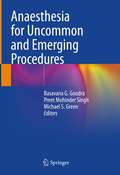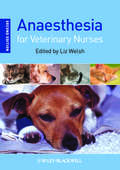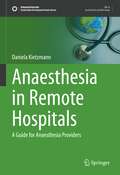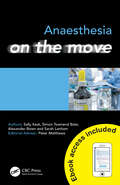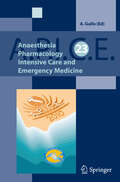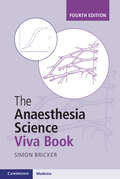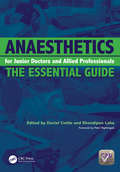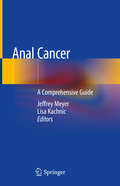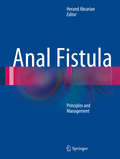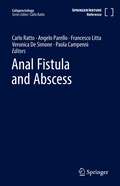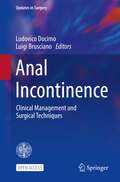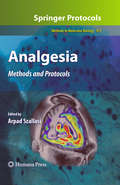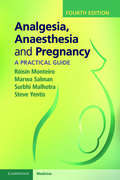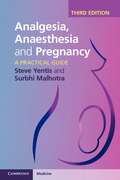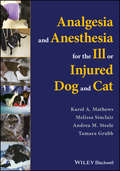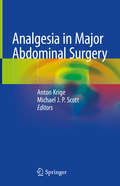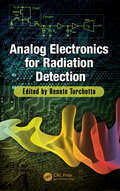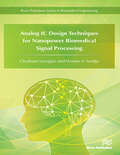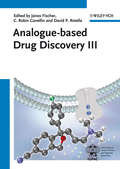- Table View
- List View
Anaesthesia for Uncommon and Emerging Procedures
by Basavana G. Goudra Preet Mohinder Singh Michael S. GreenThis book provides detailed and practical information for anesthesia providers worldwide who are challenged with providing anesthesia for both emerging and infrequently performed procedures. Concise and well-structured 42 chapters in this book provide accurate and up-to-date information that helps the reader to safely anesthetise patients presenting for a variety of procedures such as conjoined twin separation, pediatric heart and lung transplantation, pancreas and small intestine transplantation, endobariatric procedures, peroral endoscopic myotomy, jugular foramen tumors, robotic gynecological surgeries, proton beam therapy and many other complex surgeries and procedures.Anaesthesia for Uncommon and Emerging Procedures fills a unique void long felt by anesthesia providers. The book is a must for in every department or library as it provides handy reference even for providers engaged in providing anesthesia for such procedures on a regular basis. Anesthesiologists, CRNAs/AAs and those in in preoperative clinics such as hospitalists and APRN/PA providers will find this book to be an invaluable resource for optimizing outcomes in anesthesia.
Anaesthesia for Veterinary Nurses
by Liz WelshAnaesthesia for Veterinary Nurses has been written specifically for veterinary nurses by veterinary nurses and veterinary surgeons. Easy to read and understand, it provides detailed coverage of the physiological, pharmacological and physical aspects of anaesthesia. Fully updated and reflecting recent changes to veterinary nursing qualifications, this second edition is now also illustrated in colour. Sedation and anaesthesia are a crucial part of veterinary practice, and the protocols and methods involved are often complex and vary considerably from animal to animal. In addition to cats and dogs, Anaesthesia for Veterinary Nurses contains detailed sections on rabbits, rodents, birds, reptiles, and larger animals. Suitable for those with or without previous subject knowledge, this book is ideal for quick reference by veterinary nurses and technicians in practice, or for more substantial study by students. • Reflects recent changes to veterinary nursing qualifications, current terminology and drugs in use. • Includes chapters on small mammals, birds, reptiles, and large animals. • Now illustrated with colour photographs.
Anaesthesia in Remote Hospitals: A Guide for Anaesthesia Providers (Sustainable Development Goals Series)
by Daniela KietzmannThis book provides a concise and practical guide for Non-Physician Anaesthesia Providers (NPAPs) such as nurse anaesthetists and Non-Specialist Physicians working in remote settings. In many hospitals in low and even in some middle-income countries, nurse anaesthetists are working without the presence of a specialist anaesthesiologist at their hospital. During their training on the job or at one of the few schools of anaesthesia they have to act as improvising do-it-yourself-teachers for one another. Later in their professional life, NPAPs are often organising their continuous medical education themselves, trying to provide short presentations on topics between attending to patients. This book fills the need for a quick- to-read guide for the everyday work of NPAPs and Non-specialist physician anaesthesia providers, addressing challenges such as electricity failure, lack of technical support, drugs and materials, equipment and support of specialist anaesthesiologists. Anaesthesia in Remote Hospitals: A Guide for Anaesthesia Providers covers the most important fields of anaesthesia in a typical district or referral hospital in a place where resources are limited. It provides many useful tables with doses of drugs, sizes of airway equipment, infusion rate, examples of observation charts and anaesthesia records. Nurse Anaesthetists, Clinical Officers and Resident Physicians will find this book to be an essential guide to Anaesthesia within low resource and remote settings.
Anaesthesia on the Move (Medicine on the Move)
by Sally Keat Simon Bate Alexander Bown Sarah LanhamThe Medicine on the Move series provides fully flexible access to subjects across the curriculum in a unique combination of print and mobile formats ideal for the busy medical student and junior doctor. No matter what your learning style, whether you are studying a subject for the first time or revisiting it during exam preparation, Medicine on the Move will give you the support you need. This innovative print and app package will help you to connect with the topic of anaesthesia in preparation for exams and future clinical practice.By using this resource in print or as an app, you really will experience the opportunity to learn medicine on the move.
Anaesthesia, Pharmacology, Intensive Care and Emergency A.P.I.C.E.: Proceedings of the 23rd Annual Meeting - International Symposium on Critical Care Medicine
by Antonino GulloInnovation, training and research are the pillars that support a process deriving from basic science and multi-professional/multidisciplinary interventions. The APICE 2012 yearbook deals with several innovations for optimising prevention and management measures for the critically ill, by integrating diagnostic procedures with pharmacological and technological options. Peri- and postoperative managements as well as treatment of surgical infections and of pain, new and old artificial ventilation strategies are some of the most relevant topics the volume deal with in this new edition. The volume focuses also on the improvement standards and quality of care; on the expanding concept of clinical governance and professionalism and on the importance of ethical principles for establishing a process of patient-centered and evidence-based care.
The Anaesthesia Science Viva Book
by Simon BrickerThe fourth edition of the highly successful The Anaesthesia Science Viva Book provides detailed, accessible summaries of the core questions in anatomy, physiology, pharmacology, and clinical measurement and equipment that may be covered in the oral part of the Final FRCA exam. In addition to a comprehensive update, this edition includes new subject material in each of the four basic sciences, with over 200 condensed summaries of the most relevant topics in the examination. Continuing to offer candidates an insight into the way the viva works, the book provides general guidance on examination technique, and readily accessible information relating to a wide range of potential questions. Written by a former senior examiner for the Diploma of the Fellowship of the Royal College of Anaesthetists, with previous editions recommended by Anaesthesia UK, formerly a prime educational resource for trainee anaesthetists, the book remains an essential purchase for every Final FRCA candidate.
The Anaesthesia Science Viva Book
by Simon BrickerIn recent years the basic science viva of the Final FRCA has evolved a more clinical perspective. The new edition of the highly successful Anaesthesia Science Viva Book incorporates this new clinical emphasis, giving candidates an insight into the way the viva works, offering general guidance on exam technique, and providing readily accessible information relating to a wide range of potential questions. Questions are divided broadly into the four areas covered by the exam: applied anatomy, physiology, pharmacology and clinical measurement. Answers have been constructed to provide candidates with more than enough detail to pass the viva. Covering the full scope of the basic science syllabus, and written by an experienced FRCA examiner, The Anaesthesia Science Viva Book, Second Edition, is an essential purchase for every anesthesia student.
The Anaesthesia Science Viva Book: Clinical Science As Applied To Anaesthesia, Intensive Therapy And Chronic Pain, A Guide To The Oral Questions
by Simon Bricker Bricker Celyn Celyn BrickerThis third edition of the highly successful The Anaesthesia Science Viva Book contains detailed, accessible summaries of the core questions in anatomy, physiology, pharmacology and clinical measurement that may be asked in the oral section of the Final FRCA exam. In addition to comprehensive updating of all the topics, this edition includes new subject material in each of the four basic sciences, with almost 200 detailed summaries of the most relevant topics in the examination. This volume once again gives candidates an insight into the way the viva works; offering general guidance on exam technique, and providing readily accessible information relating to a wide range of potential questions. Written by a former senior examiner for the diploma of the Fellowship of the Royal College of Anaesthetists and listed as recommended reading by AnaesthesiaUK, the prime educational resource for trainee anaesthetists, it remains an essential purchase for every Final FRCA candidate.
Anaesthetic and Perioperative Complications
by Jane Sturgess Kamen Valchanov Stephen T. WebbAnaesthetic and Perioperative Complications dissects the nature of complications and helps anaesthetists and anaesthetic practitioners understand, avoid and manage them efficiently. Leading experts combine the detailed clinical management of common and important anaesthetic and perioperative complications with discussion of the key philosophical, ethical and medico-legal issues that arise with assessing a medical complication. Initial chapters discuss how and why complications occur, the prevention of complications and risk management. The main body of the text reviews the clinical management of airway, respiratory, cardiovascular, neurological, psychological, endocrine, hepatic, renal and transfusion-related complications, as well as injury during anaesthesia, complications related to regional and obstetric anaesthesia, drug reactions, equipment malfunction and post-operative management of complications. Each chapter contains sample cases of complications and medical errors, giving clinical scenario, outcomes and recommendations for improved management. This is an important practical and clinical text for all anaesthetists and anaesthetic practitioners, both trained and trainees.
Anaesthetics for Junior Doctors and Allied Professionals: The Essential Guide
by Daniel Cottle Laha ShondiponArriving in the anaesthetic room for the first time can be a daunting experience. You will be closely supervised, but everything will seem very new. Surgery is a stressful life-event for the patient and your job as an anaesthetist is to make it as safe and as comfortable as you can whilst ensuring the best outcome possible. Anaesthesia is no longer the preserve of the medical anaesthetist. It increasingly features in undergraduate and postgraduate healthcare education, and many of the competencies required need to be attained quickly, in conjunction with new drugs and equipment. This guide provides practical and clinically relevant advice in easily understandable sections to give you confidence and prepare you for your days in theatre - without the complicated physiology, pharmacology and physics. It allows you to understand the most common drugs and provides a rationale for using them. It's the perfect quick, clinical reference for dealing with common problems and emergencies; ideal for everyday use. This book is invaluable for anaesthetists starting out in their career, but is also highly recommended for Foundation, ACCS, ICM trainees, medical students, operating department trainees and nurses. It also provides an excellent revision basis for Primary FRCA candidates. 'This book provides the basic background and ground rules for how anaesthetists work, how they approach a problem and how one can prepare for it. Some of the initial chapters could be usefully read by all surgeons, especially those in Foundation Training posts, and medical students considering an anaesthetic or intensive placement. The use of lists, key points and limited use of references help make the book easy to read, or dip into between cases, and keep it a manageable size whilst still providing a mine of information for the target audience.' From the Foreword by Peter Nightingale
Anal and Perianal Conditions in Children
by Ahmed H. Al-SalemPediatric Surgery is rapidly growing, and there is a need for specialized books that cover specific topics in greater detail. This book is based on Dr Al-Salem’s extensive experience in pediatric surgery, with an emphasis on etiology, clinical features, diagnosis, and management. It is written in a straightforward, easy to read, and well-illustrated manner. The book focuses on anal and perianal conditions in children and serves as a useful and quick reference for pediatric surgeons, pediatricians, general surgeons, family physicians, emergency room physicians, fellows, residents, nurses, and students. Anal and perianal diseases are not rare in children and can cause significant discomfort, pain, disability, and disruption to the daily routine of both the child and their family. These conditions include both congenital and acquired diseases, such as anal fissures, rectal prolapse, hemorrhoids, perianal abscesses, and fistulas. Other disorders include sacrococcygeal teratoma, anorectal malformations, and anterior ectopic anus. Additionally, perianal dermatitis, which can be allergic, bacterial, fungal, diaper-related, or contact-induced, is a common inflammatory condition affecting infants and children. While anal and perianal diseases in children are usually benign, it is crucial to diagnose and treat them early to exclude more serious conditions, including inflammatory bowel diseases. Diagnosis relies on a thorough medical history, careful physical examination, and, rarely, endoscopy and radiology. Management includes both medical and surgical options, and with early diagnosis and treatment, the prognosis is excellent.
Anal and Rectal Diseases: A Concise Manual (Remedica Explained S. Ser.)
by Mark Singer Eli D. Ehrenpreis Shmuel AvitalAnal and Rectal Diseases: A Concise Manual provides a succinct reference on the subject for clinicians, including primary care physicians, gastroenterologists, general surgeons, physician's assistants and nurse practitioners. Presented in a consistent structural style that provides both a general summary of individual topics within the field along with additional details to assist those with some background knowledge in the subject area, this handy volume provides information related to the field of anorectal disease in a format that is easily accessible for rapid acquisition of knowledge. Each topic is outlined in a multidisciplinary fashion with the medical, surgical, and pathological aspects clearly detailed in each section. Each section clearly describes the condition with up-to-date management guidelines and precious clinical pearls. The volume features high quality illustrations in the form of elegant hand drawn figures, tables, photographs of physical findings, endoscopic finds and radiographs. The clinical photographs and x-rays will be of great value to gastroenterologists whose specialty is not coloproctology. Chapters on computerized tomographic colography (virtual colonoscopy) and others cover the newer technologies employed for diagnostic purposes in these diseases. Anal and Rectal Diseases: A Concise Manual provides clinicians with a tool for rapid consultation for direct patient care and management.
Anal Cancer: A Comprehensive Guide
by Jeffrey Meyer Lisa KachnicThis book is a comprehensive overview of the epidemiology, pathogenesis, and treatment options available for anal cancer. Anal cancer is a relatively rare disease, but one increasing in incidence. Strides have been made in developing treatment paradigms through clinical trials, and proper management requires multidisciplinary interaction between radiation oncologists, surgeons, and medical oncologists as well as other physicians, nurses, and other medical professionals. The book thus covers all aspects of the disease to give clinicians and their teams the information necessary to develop a treatment program that focuses on improved patient outcomes. Chapters cover evaluation of the patient and cancer staging, current standard treatments, epidemiology, pathogenesis, issues involved in survivorship, and ongoing and future avenues of research into disease biology and novel treatments. This book is an ideal resource for clinicians involved in the care of patients with anal cancer.
Anal Fissure: Symptoms, Diagnosis and Therapies
by Volker Wienert Franz Raulf Horst MlitzThis highly informative monograph offers a comprehensive and interdisciplinary reference guide for the management and treatment of the whole spectrum of painful tears in the anus and anal canal. Based upon a systematic review of all relevant papers on the topic since 1865, it addresses primary, acute and chronic anal fissures - providing a new definition of the last form - and secondary anal fissures in detail, particularly their medical history, etiology, signs and symptoms, medical findings, therapy and its evaluation, and differential diagnosis. The book also covers all available evidence-based therapeutic strategies. As such, it will appeal to a wide readership, from proctologists and surgeons to gynecologists, urologists, dermatologists and gastroenterologists.
Anal Fistula: Principles and Management
by Herand AbcarianAnal Fistula: Principles and Management provides a comprehensive and state of the art review of major issues specific and related to the treatment of anal fistulas. An important section of the book covers the large number of alternative procedures which have been developed in the last two decades. Needless to say, none of these procedures have been uniformly successful, otherwise there would be no need for all the different operations. The book addresses each alternative procedure, discusses the benefits of each procedure, includes the most up-to-date results. Other important chapters cover the causes and failure of treatment and operations for fistulas. Also included is a Cochrane Review of all available randomized controlled trials with levels of evidence culled from the literature. Written by specialists in their respective fields, Anal Fistula: Principles and Management fills a void in available texts on a subject matter very commonly encountered by surgeons, physicians and specialists.
Anal Fistula and Abscess (Coloproctology)
by Carlo Ratto Angelo Parello Francesco Litta Veronica De Simone Paola CampennìThis volume comprehensively describes the anatomy, pathophysiology, diagnostics, and modalities of treatment of one of the most complex and debated clinical conditions in coloproctology: anal fistulas and abscesses. It also debates current controversies and presents the best approaches based on the authors’ clinical expertise. Providing an in-depth understanding of the anal canal anatomy and surrounding area, it enables readers to manage anal sepsis and avoid excessive damage, in particular to the anal sphincters. Further, the book presents insights into the pathophysiological processes (in cryptoglandular and Crohn’s disease) causing abscess and fistula, which have a significant impact on the management of these conditions. It also discusses diagnostic assessments crucial for selecting the optimal surgical technique and offers guidance on the timing. Lastly, it assesses the pros and contras of the various surgical procedures, evaluating the possible outcome in terms of both therapeutic success and detrimental effects on the anorectal functions. As such it is a valuable resource for all physicians involved in the management of anal fistulas and abscesses (coloproctologists, general surgeons, gastroenterologists, radiologists).
Anal Incontinence: Clinical Management and Surgical Techniques (Updates in Surgery)
by Ludovico Docimo Luigi BruscianoThis open access book describes the latest advances in the anal incontinence diagnostic and therapeutic processes. Anal incontinence is a devastating condition heavily impacting on the patients’ lives. Those suffering from this disorder are generally very embarrassed and reluctant to undergo an appropriate clinical evaluation, thus becoming more isolated and worsening the quality of their life. Luckily, nowadays a wide range of treatments is available to improve this oppressive condition; however, the recognition of the related pathophysiological alterations is mandatory to grant its successful management. This volume will help the surgeons community to keep abreast of developments in diagnostics and treatment of this impairing condition. and will provide all health professionals with the appropriate tools to face this impairing condition.
Analgesia: Methods and Protocols (Methods in Molecular Biology #617)
by Arpad SzallasiChronic pain is a complex phenomenon, which continues to remain undertreated in the majority of affected patients thus representing a significant unmet medical need, but the development of cellular, subcellular, and molecular methods of approaching this epidemic of pain shows great promise. In Analgesia: Methods and Protocols, experts in the field present thorough coverage of molecular analgesia research methods from target discovery through target validation and clinical testing to tolerance and dependence, with extensive chapters on emerging receptor classes as targets for analgesic drugs and innovative analgesic strategies. As a volume in the highly successful Methods in Molecular BiologyTM series, the chapters include introductions to their respective topics, lists of the necessary materials and reagents, step-by-step, readily reproducible protocols, and notes sections with tips on troubleshooting and avoiding known pitfalls. Comprehensive and essential, Analgesia: Methods and Protocols promises to aid and enrich the research of all those scientists and clinicians who are interested in what the increasingly molecular future has in store for analgesia research, from the molecular research bench through the animal laboratory to the bedside.
Analgesia, Anaesthesia and Pregnancy: A Practical Guide
by Róisín Monteiro Marwa Salman Surbhi Malhotra Steve YentisNow in its fourth edition, Analgesia, Anaesthesia and Pregnancy is a concise guide to obstetric anaesthesia and analgesia. This essential text reviews every topic and clinical challenge faced during delivery and focuses on pre-empting problems and maximising quality of care. It also covers acute emergencies related to pregnancy. This new edition features 11 new chapters that cover the significant updates in the field over the last few years. Presented in a clearly structured format, this practical guide will be an invaluable source of key information for any anaesthetist encountering obstetric patients, whether they are a practised consultant or still in training. Obstetricians, neonatologists, midwives, nurses, and anaesthetic assistants in obstetric analgesia and anaesthesia who wish to extend or update their knowledge will also benefit from reading this book.
Analgesia, Anaesthesia and Pregnancy
by Steve Yentis Surbhi MalhotraAnalgesia, Anaesthesia and Pregnancy focuses on pre-empting problems and maximising quality of care. Every chapter of this well-established practical guide has been completely updated and revised. All aspects of obstetric medicine relevant to the anaesthetist are covered, from pre-pregnancy management to conception, throughout pregnancy, to postnatal care. The authors have identified over 150 potential complications, each covered in two parts: 'problems/special considerations' and 'management options', with key points prominently displayed for quick reference. A section on organisational aspects such as record keeping, training protocols and guidelines makes this an important resource for any labour ward or hospital dealing with pregnant women. Presented in a clear, structured format, this practical summary will be invaluable to any anaesthetist encountering obstetric patients, whether they are a practiced consultant or still in training. It will also be useful for obstetricians, neonatologists, midwives, nurses and operating department practitioners wishing to extend or update their knowledge.
Analgesia and Anesthesia for the Ill or Injured Dog and Cat
by Karol A. Mathews Melissa Sinclair Andrea M. Steele Tamara GrubbAnalgesia and Anesthesia for the Ill or Injured Dog and Cat provides a comprehensive guide to anesthesia and pain management protocols, specifically tailored to ill or critically injured dogs and cats. Provides fast access to anesthesia and pain management protocols specifically tailored to ill or critically injured dogs and cats Takes a case-based structure to make it easy to find and apply relevant information Presents step-by-step clinical procedures and techniques Supplies concise, relevant background information for all drugs recommended in the protocols, highlighting recommendations and cautions for specific patient conditions Includes detailed information for geriatric, pregnant, nursing, and pediatric patients and those with cardiac, liver or kidney pathology
Analgesia in Major Abdominal Surgery
by Anton Krige Michael J. ScottThis book presents current evidence in an Enhanced Recovery Programme context, and provides a common sense approach to using the array of available analgesia techniques appropriately in major abdominal surgery. Current pain relief options are discussed, many of which have been described only in the last ten years. Topics covered range from the now widespread use of portable ultrasound machines to an appreciation of the value of some older drugs in a new context. Analgesia for Major Abdominal Surgery is aimed at anesthetists, acute pain teams, and acute pain nurses, as well as colorectal, hepatobiliary, urological and gynecological surgeons.
Analog Electronics for Radiation Detection (Devices, Circuits, and Systems)
by Renato TurchettaAnalog Electronics for Radiation Detection showcases the latest advances in readout electronics for particle, or radiation, detectors. Featuring chapters written by international experts in their respective fields, this authoritative text: Defines the main design parameters of front-end circuitry developed in microelectronics technologies Explains the basis for the use of complementary metal–oxide semiconductor (CMOS) image sensors for the detection of charged particles and other non-consumer applications Delivers an in-depth review of analog-to-digital converters (ADCs), evaluating the pros and cons of ADCs integrated at the pixel, column, and per-chip levels Describes incremental sigma–delta ADCs, time-to-digital converter (TDC) architectures, and digital pulse-processing techniques complementary to analog processing Examines the fundamental parameters and front-end types associated with silicon photomultipliers used for single visible-light photon detection Discusses pixel sensors with per-pixel TDCs, channel density challenges, and emerging 3D technologies interconnecting detectors and electronics Thus, Analog Electronics for Radiation Detection provides a single source for state-of-the-art information on analog electronics for the readout of radiation detectors.
Analog IC Design Techniques for Nanopower Biomedical Signal Processing (River Publishers Series In Biomedical Engineering Ser.)
by Chutham Sawigun Wouter A. SerdijnAs the requirements for low power consumption and very small physical dimensions in portable, wearable and implantable medical devices are calling for integrated circuit design techniques using MOSFETs operating in the subthreshold regime, this book first revisits some well-known circuit techniques that use CMOS devices biased in subthreshold in order to establish nanopower integrated circuit designs. Based on the these findings, this book shows the development of a class-AB current-mode sample-and-hold circuit with an order of magnitude improvement in its figure of merit compared to other state-of-the-art designs. Also, the concepts and design procedures of 1) single-branch filters 2) follower-integrator-based lowpass filters and 3) modular transconductance reduction techniques for very low frequency filters are presented. Finally, to serve the requirement of a very large signal swing in an energy-based action potential detector, a nanopower class-AB current-mode analog multiplier is designed to handle input current amplitudes of more than 10 times the bias current of the multiplier circuit. The invented filter circuits have been fabricated in a standard 0.18 µ CMOS process in order to verify our circuit concepts and design procedures. Their experimental results are reported.
Analogue-based Drug Discovery III
by David P. Rotella Janos Fischer C. Robin GanellinMost drugs are analogue drugs. There are no general rules how a new drug can be discovered, nevertheless, there are some observations which help to find a new drug, and also an individual story of a drug discovery can initiate and help new discoveries. Volume III is a continuation of the successful book series with new examples of established and recently introduced drugs. The major part of the book is written by key inventors either as a case study or a study of an analogue class. With its wide range across a variety of therapeutic fields and chemical classes, this is of interest to virtually every researcher in drug discovery and pharmaceutical chemistry, and -- together with the previous volumes -- constitutes the first systematic approach to drug analogue development.
